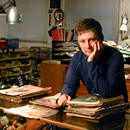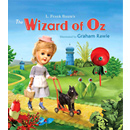WW: Why
a
new version of the Wizard of Oz?
GR: I’ve
always loved The Wizard of Oz and considered
it to be one of the all-time great stories, but this view was based on
countless viewings the 1939 movie; I’d never actually read the book. I
was
fascinated by what I found in the original text: numerous characters
and scenes
that never made it to the movie and lots of backstory that add depth to
the
characters. You find out the history of the Winged Monkeys and how the
Tin Man
came to be made of tin. I don’t think you can top the movie; it’s
utterly
brilliant, but I thought there was room for a visual reinterpretation
of Baum’s
original text. I’ve remained loyal to the original story, but my own
vision of
Oz comes through and I hope my pictures highlight other dimensions in
the
story.
WW: As
someone from the U.K., how does an American fairy tale resonate with
you?
GR: It
has incredible psychological depth and has, at
its heart a wonderful message and a valuable life lesson: that we all
need to
go on a journey of discovery before we can become complete. That’s why
it
resonates with the whole world. Though its theme is universal, I like
the fact
that it is firmly rooted in American soil of the Kansas prairie because
though
by contrast the wonderful land of Oz is so spectacular, it is still
governed by
the ideals of a real world.
WW: How
many
of the Oz books have you read?
GR:
I decided that while I was working on this book I
wouldn’t read any of the others. I didn’t want to be influenced by
facts that
might inform or change my take on the original story. Now, after two
years my
book is finished, I am free to sit down and read them all at my
leisure. Baum
was a great writer.
WW:
Assuming
you’ve read a few of the others by now, have you found any other
characters that
you’d enjoy
creating models for?
GR:
Baum invents and designs wonderful characters.
From a purely visual point of view, characters like the Saw Horse and
The Gump
from The Marvelous Land of Oz. An animal with a hunting trophy as a
head is a
genius idea and I wish I’d thought of it.
WW: Who
are
the people portrayed as the Wizard and the Good Witch?
GR:
The Good Witch of the North is the late Hattie
Summers-Ehasz, a nice-looking lady I found on a photo library site. I
contacted
the family to check that they were happy for me to use the picture. The
Wizard
is from a similar site, but there was no way to contact him. Glinda,
the Good
Witch of the South’s face is made from half a dozen Hollywood film
stars, but
everyone seems to be able to see one in particular, Elizabeth Taylor,
even
though I only used her nose and forehead.
WW: Did
you
happen to use any features of Billie Burke or Margaret Hamilton by
chance?
GR:
No, nothing nearly so clever, I’m afraid.
WW: Who
are
some of the artists you admire?
GR: It
would be too hard to start listing them, but I
am inspired by a broad range of art and artists. My pictures for Oz are
perhaps
more influenced by cinema than illustration. Building the sets
characters,
costumes and props for Oz was rather like making a movie (or creating
movie
stills) in miniature.
WW: You
use
a lot of found items in your work. What one item excited you the
most for
this project?
GR:
Dorothy. She’s a doll I used in another book and
she has such a lovely face. The original doll (then called Gloria) was
much too
grown up so her body had to be replaced, but now she seems so perfect
as
Dorothy, I think she’ll stay that way. I was also very excited to find
my
Cowardly Lion, who I discovered after a very long search in a junk
store in
Minneapolis. He’s a bit moth-eaten and he’s lost his growl and his
teeth and he
looks permanently nervous. Perfect for the role. As a sitting wind-up
toy, he
has no lower legs, so these had to be created digitally for each shot.
WW: You
obviously put a lot of thought and research into your creations.
Is there
a message you want to convey through your art?

GR:
I think my approach is always the same. I do the
work first and foremost to please myself, but I agonize over everything
until
it feels right. (I spent six months building an Emerald City; I didn’t
like the
end result so I scrapped the whole thing and started again). Everything
I do
seems somehow related to my childhood in an attempt to recapture
something from
it that I
feel was lost, so it seems like it’s a part of me, and that hopefully
gives it authenticity. I’m also a great believer in the idea that the
greater
the constraints of an exercise, the more inventive you become. I often
impose
such rules on myself.
WW: The
animated trailer is quite interesting. Tell me more about your
experience
in directing it and working with Pete Mellor.
GR:
Pete Mellor is brilliant. He’s a good friend and a
very clever animator; we’ve been trying to work on something together
for
years. With very little money and very little time, he managed to get
my
pictures moving, usually with nothing more than the flat finished
photograph to
work from. Though he works digitally, we were careful to maintain the
hand-made
feel of the pictures. I particularly enjoyed assembling the soundtrack
from
dozens of tiny fragments of found music. Now we’re hoping for funding
to embark
on animating the whole story as a film.
WW: Oz
seems
to be enjoying a renaissance in popular media lately.
There are a few versions of a darker Oz like
“Tin Man” and “Apocalypse Oz” as well as Disney’s sequel “Return to Oz”. If you do pursue a film with Pete Mellor,
what direction do you think you would take?
GR:
As with the book, I’d want to remain faithful to
the original story, though of course it would need serious editing;
what works
on the page won’t necessarily work on the screen. I think of my version
as
strange and (hopefully) magical, rather than particularly dark. There
is a lot
of potential humour that I would want to exploit. The trailer was
partly an
experiment to see how the book images would translate to the screen and
I
really like the feel of it.
WW: Can
you
name some of your favorite movies besides The Wizard of Oz?
GR:
If you’re talking about visually inspiring movies,
it’s hard to top The Wizard of Oz, but The 10,000 Fingers of Doctor T
has some
extraordinary design in it. I’m generally interested in great stories
so the
films I watch over and over again are often cinema classics: Billy
Wilder’s The Apartment, Some Like it Hot, Double
Indemnity.
I love It’s a Wonderful Life.
Hitchcock: Vertigo, Rear Window, North by Northwest. For sheer
indulgence I’m
also very fond of British comedies from the early sixties (probably a
childhood
thing) as well as the grittier films from that period, Saturday Night,
Sunday
Morning, A Kind of Loving etc. I have modern favourites too: Fargo,
Pulp
Fiction…Little Miss Sunshine is a great film. I could go on, but the
list only
highlights those I leave out.
WW: Do
you
have any plans for illustrating another classic children's book?
GR:
This was the first time I’d ever illustrated
someone else’s text. I normally prefer to write my own stories, but I
decided
that if I were ever to work on someone else’s, it would be The Wizard
of Oz.
Now it’s done, I’m back to writing a novel that got put on hold while I
did Oz.
I loved doing Oz, but I can’t imagine I’ll do another children’s book,
but who
knows?
WW: Do
you
find that your work on The Wizard of Oz has influenced your new novel
in any
way?
GR:
At the moment I’m at the stage where I’m trying to
wrestle my unwieldy plot into some shape, but it is a quest story so
structurally has similarities with The Wizard of Oz, the perfect model
of The
Hero’s Journey. To keep mine on track I keep reminding myself of the
central
question: what does my character want/need, does he get it, and
assuming he
does, what does he need to sacrifice/learn in order to do so? Makes it
sound so
easy, doesn’t it?
WW: What
question would you ask L. Frank Baum if he were alive today?
GR:
‘Can you ever forgive me for putting Toto on
wheels?’ No, I wouldn’t ask that. He’d understand my thinking, I hope.
Unlike
the film where Toto is instrumental in much of the plot, in the book he
doesn’t
do very much, so it seemed appropriate (and funny) to make him a
push-along
toy. It also tells us something about Dorothy’s take on reality and
therefore
paints the picture of Oz in a different light.
What would I really ask? I
suppose I’d be interested in his reaction to other interpretations of
his
story. Mine in particular, obviously, but wouldn’t it be great to sit
him down
to watch the 1939 MGM movie and then ask him what he thought about it?
For
once, I’d be very happy to turn my back to the screen as the film
played, just
to watch his face. ∆
Graham Rawle lives in London, U.K. and is a lecturer on
the Sequential Design and Illustration MA at Brighton. He has
authored several books for adults and children. He can be reached
at www.grahamrawle.com
Blair Frodelius lives in upstate New York and is the
editor of The International Wizard of Oz Club's Website; The Daily
Ozmapolitan; and OzProject.com. He can be reached at
blair@frodelius.com
--Interviewed by Blair Frodelius; Nov 17 & 24, 2008
Home Again


 ...
... 

